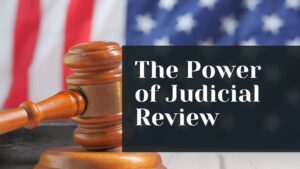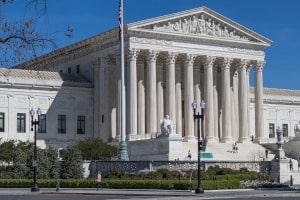How Would Eliminating the Power of Judicial Review Weaken Courts in the United States?
What Is Judicial Review?
In America, judicial review refers to the power of the courts to examine laws and other government actions to decide if they violate or contradict previous laws, the country's constitution, or the federal constitution. If a law is alleged to be unconstitutional, it is overturned (or "struck down") in whole or in part.

Judicial review is a vital and influential power that allows the judicial branch of the authorities to prevent local, state, and federal governments from taking unconstitutional actions.
While the Supreme Court has historically attempted to utilize its power to overturn laws every bit a final resort in cases where the police's unconstitutionality is clear, the looming threat of judicial review influences legislators as they craft bills and regulations.
What Gives Courts the Power of Judicial Review?
Judicial review is non explicitly defined in the United States Constitution. Instead, it's strongly implied when certain passages are considered together. The judicial organization is given the concluding authority to make up one's mind which law to uphold, and in Article 4, the Constitution is named the "supreme Law of the Country." When combined, these elements seem to requite courts the duty to uphold the Constitution over any contradictory laws whenever a discrepancy appears.
Did the Framers Intend Judicial Review?
Despite the lack of an explicit passage outlining the power of judicial review, modern scholars remember that the framers of the Constitution very much intended this power to exist. The framers spoke a dandy deal about judicial review during the Constitutional Convention and during state ratification debates. The Federalist Papers referred to the concept several times, about extensively in Federalist no. 78 and Federalist no. fourscore.
Additionally, six states explicitly stated that they thought that federal courts had the power to review the constitutionality of laws in their responses to the Kentucky and Virginia Resolutions in 1798. In other words, nearly one-half of the original xiii states interpreted the Constitution as granting the judiciary the power of judicial review a scant handful of years after it was written and well earlier Marbury v Madison.
Prior to Marbury v Madison
Federal courts examined the constitutionality of federal statutes several times before 1803, merely no active law was overturned earlier Marbury v Madison . In Hayburn'southward Case , decided in 1792, three federal circuit courts ruled that the same law was unconstitutional. The law delegated the review of pension applications to circuit court judges. These courtroom decisions were appealed to the Supreme Court, merely the law was repealed by legislators before the appeal could take place.

Judicial review of federal legislation occurred in 1796 in Hylton five United States , but the Supreme Court held that the law in question was constitutional. The 1796 Supreme Courtroom did strike down a Virginia statute concerning pre-Revolutionary State of war debts, finding the police in question contrary to a peace treaty betwixt the US and Neat Uk. Under the Constitution's Supremacy Clause, the court struck the constabulary downwards.
Between 1798 and 1800, the ruling in Marbury v Madison was foreshadowed clearly. The findings in the 1798 case Hollingsworth v Virginia relied on an estimation of the Eleventh Amendment's limitations on the jurisdiction that strongly implied that the Supreme Court would find the Judiciary Human action of 1789 unconstitutional.
Justice Chase penned the opinion in Cooper v Telfair in 1800 and included a argument that indicated that most judges felt that the Supreme Court had the power to detect a federal law unconstitutional. However, it had not done so notwithstanding. The power was not exercised until Marbury v Madison in 1803.
Marbury v Madison
In 1803, the Marshall court struck downward the Judiciary Act of 1789. The law gave the Supreme Court the power to issue writs of mandamus that would force courts or officials to practise their duties. Article Iii of the Constitution directly stated that the Supreme Courtroom would have appellate jurisdiction over all but a very narrow subset of cases. Marbury v Madison held that the Judiciary Act of 1789 was unconstitutional. The Marshall court interpreted the Judiciary Human action of 1789 as giving the court original jurisdiction over cases where a petitioner sought the courtroom to issue a writ of mandamus.
Legal scholars have lauded the politics backside the exact ruling reached in Marbury v Madison for centuries. While the Supreme Court struck downward the Judiciary Human activity, it did so in a way that benefited the incumbent administration. This gave footling incentive for the authoritative co-operative of the government to challenge the ruling in a fashion that would weaken the nascent Supreme Court'south power.
Some scholars theorize that the ruling was the only i that would have been enforced, as had the Supreme Court upheld the Judiciary Act of 1789 and issued a writ of mandamus, the Jefferson administration would have simply ignored the writ and weakened the Supreme Court forever.
Stare Decisis
In one case Marbury v Madison was decided, judicial review became enshrined in constabulary by a practise called stare decisis. Under stare decisis, courts try to let decisions and legal deportment fabricated by previous courts stand up unless there's a very potent reason to overturn them. The more a decision or activeness is relied upon for precedent, the less likely a future court is to overturn it.
For centuries, judicial review has been a key part of U.s.a. code and court cases. Even if something inverse dramatically in our estimation of the constitution that caused legal scholars to terminate thinking that the constitution unsaid the power of judicial review, it's doubtful that whatever courtroom would overturn judicial review without a ramble amendment.
Judicial Review Throughout History
After Marbury v Madison, the Supreme Courtroom did not strike down a federal law every bit unconstitutional for fifty years. While the fear of judicial review being challenged and potentially overturned likely had something to do with this, it'south likewise worth noting that many of the framers of the constitution were alive during many of these 50 years and that legislators were respectful of the supremacy of the newly enshrined constitution. The Supreme Court did, however, concord that some state constabulary was unconstitutional and had no qualms about using its judicial supremacy to strike such legislation down.
Dred Scott v Sandford
The adjacent law to be struck down as unconstitutional was the Missouri Compromise, which outlined which new territories added to the United states would allow slavery. The case, Dred Scott 5 Sandford, was heard in 1857 and held that the U.s. Constitution never intended anyone of African descent to exist considered a citizen of the United States. The Civil War occurred four years later on.
Historians often betoken to the Dred Scott conclusion as one of the turning points in the rising tension between slaveholding states and the free North. In 1865, the 13th subpoena overturned Dred Scott past abolishing slavery and explicitly granting citizenship to all persons born or naturalized in the United states of america.
Modern Judicial Review
Judicial review is a cornerstone of the modern United states of america. By 2017, 182 federal statutes had been held unconstitutional in whole or in part. Justices take traditionally erred on the side of caution and attempted to exercise the power of judicial review as a terminal resort.

That said, the court's history of hitting down laws suggests that either lawmakers are being more brazen in their efforts to skirt the edges of what the constitution allows, or the Supreme Courtroom is more willing to step in and intercede on edge cases. Modern political discussions surrounding abortion, gun control, and religious freedom ofttimes center around the Supreme Court's ramble estimation and the amendments that surround those issues.
Recent applications of judicial review include:
- Citizens United v Federal Election Commission (2010), in which the court struck down a police that interfered with the power of corporations and associations to spend coin on ballot advertising.
- National Federation of Independent Business organisation five Sebelius (2012), in which the court upheld the constitutionality of much of the Patient Protection and Affordable Health Care Act, sometimes chosen "Obamacare."
The Court's Reluctance To Strike Downward Laws
In general, the Supreme Court has attempted to avert ruling on the constitutionality of a constabulary if it tin can decide the outcome before it past any other ways. When it must claiming the constitutionality of a law, it attempts to practice so in the most limited fashion possible, striking down as trivial of the law as it can. Justice Brandeis famously outlined seven rules that the Supreme Court tends to follow when information technology reviews laws:
- The court requires a live, contentious case before it volition rule.
- It will not issue opinions in accelerate of a case.
- It volition interpret the constitution as narrowly as it can.
- A ruling on the constitutionality of a law is only used as a concluding resort if other factors cannot decide the example.
- One of the petitioners in the case must have really been adversely afflicted by the unconstitutional law.
- Someone who benefits from a police cannot challenge its constitutionality.
- The law volition be interpreted in the virtually favorable style regarding its constitutionality.
Preventing Judicial Review
Nether Commodity Iii of the Constitution, Congress can curtail the Supreme Court's appellate jurisdiction. This means that Congress can limit the potency of the Supreme Courtroom to hear cases regarding certain laws. This power has occasionally been utilized, although non ever successfully. Notably, the Detainee Treatment Act of 2005 and the Military Commissions Act of 2006 were ruled unconstitutional despite language in both laws that attempted to limit their ability to exist reviewed by courts.
brodersenyoulation.blogspot.com
Source: https://constitutionus.com/law/the-power-of-judicial-review/
0 Response to "How Would Eliminating the Power of Judicial Review Weaken Courts in the United States?"
Post a Comment